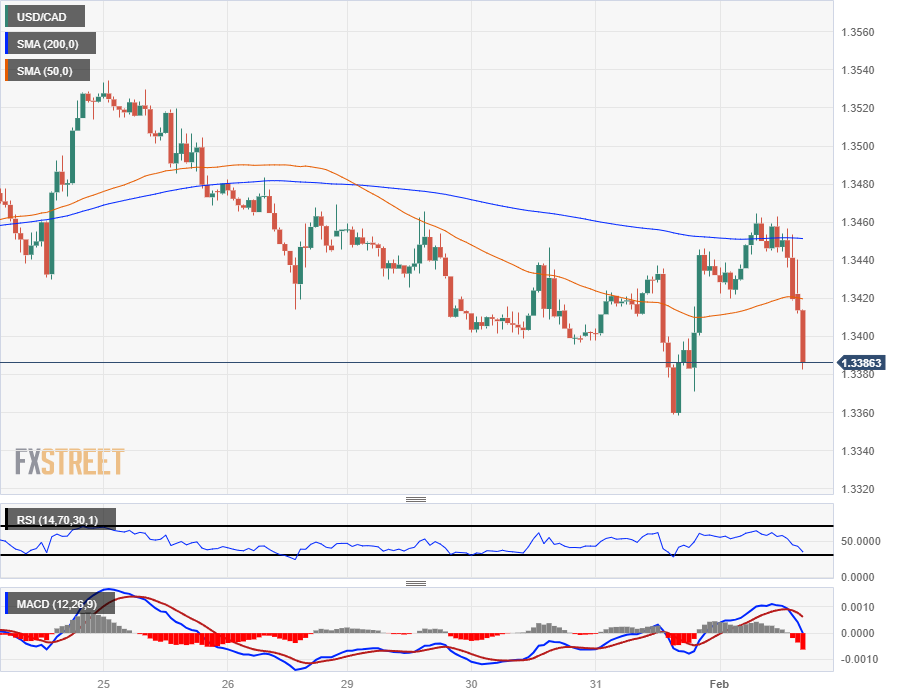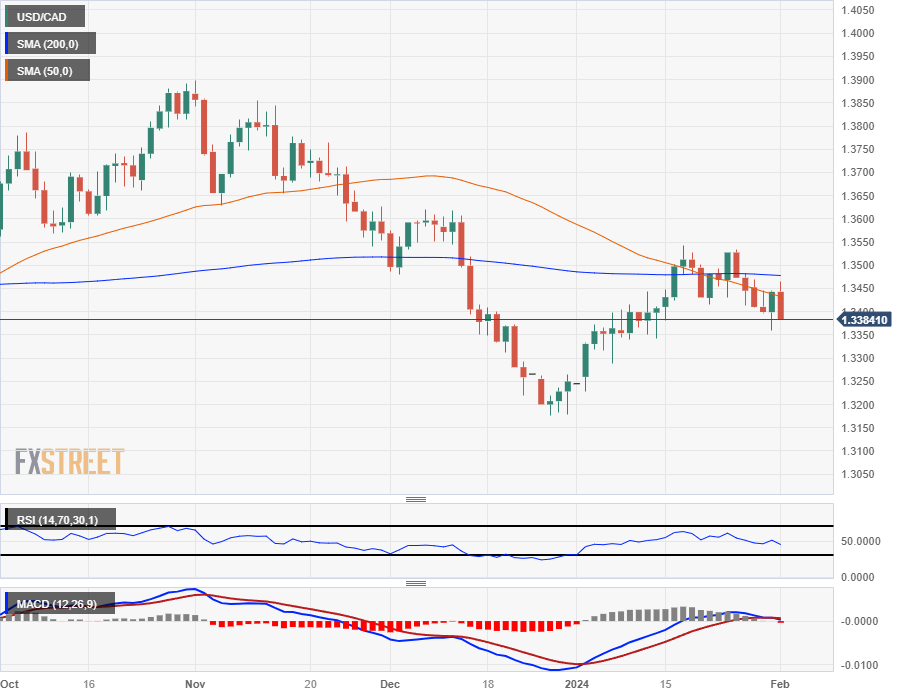- Analytics
- News and Tools
- Market News
- Canadian Dollar softens on Thursday in pre-NFP market churn
Canadian Dollar softens on Thursday in pre-NFP market churn
- Canadian Dollar mixed on Thursday as Crude Oil flattens.
- Canada saw an improvement in Manufacturing PMIs for January.
- Markets gear up for another US NFP on Friday.
The Canadian Dollar (CAD) is broadly mixed against a basket of major currencies on Thursday but sees some gains against the US Dollar (USD). Markets are settling following Wednesday’s Federal Reserve (Fed) outing that saw Fed Chairman Jerome Powell strike a much more hawkish tone than many investors expected. This knocked equity markets lower and drove risk-off flows into the safe haven US Dollar.
Canada saw an uptick in the S&P Global Manufacturing Purchasing Managers Index (PMI) for January, but the indicator of production confidence remains in contractionary, sub-50.0 territory. US ISM Manufacturing PMIs likewise printed above expectations, but similarly remain below 50.0. US Initial Jobless Claims unexpectedly jumped, coming in above the four-week average for US jobless benefits seekers.
Daily digest market movers: Canadian Dollar finds some room to recover against Greenback
- The Canadian Manufacturing PMI printed at 48.3 for January, stepping over the previous month’s 45.4, a sharp recovery from December’s three-and-a-half-year low.
- US Initial Jobless Claims for the week ended January 26 printed at 224K versus the forecasted 212K. Last week's jobless tickets came in at 215K.
- US Initial Jobless Claims posted their highest print since November 10, accelerating above the four-week average of 207.75K.
- The US ISM Manufacturing PMI recovered to 49.1 in January compared to the forecasted tick down to 47.0 from December’s 47.1, its highest reading in 16 months.
- US ISM Manufacturing Prices Paid also rose to a 9-month high of 52.9 compared to the forecasted jump to 46.9 from December’s 45.2 as producer-level inflation bites.
- The trading week will close out with another high-impact US Nonfarm Payrolls (NFP) print on Friday.
- US NFP job additions are forecast to tick down to 180K in January compared to December’s 216K.
- Market NFP forecasts have undershot the actual NFP print in all but four of the last 21 consecutive releases.
- Crude Oil markets have flattened after a panicked rise that saw West Texas Intermediate (WTI) US Crude Oil climb over $79 per barrel last week.
- Crude Oil bids have receded, allowing WTI to settle just above $76.00.
- NFP Preview: Forecasts from 10 major banks
Canadian Dollar price today
The table below shows the percentage change of Canadian Dollar (CAD) against listed major currencies today. Canadian Dollar was the strongest against the US Dollar.
| USD | EUR | GBP | CAD | AUD | JPY | NZD | CHF | |
| USD | -0.57% | -0.37% | -0.41% | -0.10% | -0.61% | -0.38% | -0.56% | |
| EUR | 0.57% | 0.20% | 0.14% | 0.49% | 0.00% | 0.19% | 0.01% | |
| GBP | 0.38% | -0.19% | -0.06% | 0.32% | -0.19% | -0.01% | -0.19% | |
| CAD | 0.39% | -0.16% | 0.06% | 0.33% | -0.14% | 0.06% | -0.13% | |
| AUD | 0.10% | -0.49% | -0.31% | -0.35% | -0.49% | -0.27% | -0.45% | |
| JPY | 0.58% | 0.00% | 0.19% | 0.14% | 0.46% | 0.14% | 0.02% | |
| NZD | 0.38% | -0.17% | 0.02% | -0.02% | 0.29% | -0.22% | -0.17% | |
| CHF | 0.55% | -0.02% | 0.19% | 0.10% | 0.46% | -0.05% | 0.16% |
The heat map shows percentage changes of major currencies against each other. The base currency is picked from the left column, while the quote currency is picked from the top row. For example, if you pick the Euro from the left column and move along the horizontal line to the Japanese Yen, the percentage change displayed in the box will represent EUR (base)/JPY (quote).
Technical Analysis: Canadian Dollar recovers against US Dollar, mixed in Europe and Oceania
The Canadian Dollar (CAD) has rebounded a quarter of a percent against the US Dollar on Thursday, but shed around a quarter of a percent against the Japanese Yen (JPY), the market’s single best-performing currency for the day. The Canadian Dollar eased slightly against the Euro (EUR) and the Swiss Franc (CHF) as market activity focused elsewhere, but it climbed around a third of a percent against the Australian Dollar (AUD).
USD/CAD dipped back below the 1.3400 handle once again for the fourth time in two days as the Dollar-Loonie pair roils on market sentiment. The pair recovered to 1.3460 early Thursday after Wednesday’s Fed-fueled churn, reaching a near-term low of 1.3360.
USD/CAD is heading back into downside territory near 1.3380, with Thursday’s peak etching in a rejection from the 200-hour Simple Moving Average (SMA). Thursday’s nearish push drives the USD/CAD toward the low end of near-term congestion that has plagued the pair on daily candlesticks. Intraday action is set to remain capped by the 200-day SMA just below the 1.3500 handle.
USD/CAD hourly chart
USD/CAD daily chart
Economic Indicator
United States Nonfarm Payrolls
The Nonfarm Payrolls release presents the number of new jobs created in the US during the previous month in all non-agricultural businesses; it is released by the US Bureau of Labor Statistics (BLS). The monthly changes in payrolls can be extremely volatile. The number is also subject to strong reviews, which can also trigger volatility in the Forex board. Generally speaking, a high reading is seen as bullish for the US Dollar (USD), while a low reading is seen as bearish, although previous months' reviews and the Unemployment Rate are as relevant as the headline figure. The market's reaction, therefore, depends on how the market assesses all the data contained in the BLS report as a whole.
Read more.Next release: 02/02/2024 13:30:00 GMT
Frequency: Monthly
Source: US Bureau of Labor Statistics
Why it matters to traders
America’s monthly jobs report is considered the most important economic indicator for forex traders. Released on the first Friday following the reported month, the change in the number of positions is closely correlated with the overall performance of the economy and is monitored by policymakers. Full employment is one of the Federal Reserve’s mandates and it considers developments in the labor market when setting its policies, thus impacting currencies. Despite several leading indicators shaping estimates, Nonfarm Payrolls tend to surprise markets and trigger substantial volatility. Actual figures beating the consensus tend to be USD bullish.
Canadian Dollar FAQs
What key factors drive the Canadian Dollar?
The key factors driving the Canadian Dollar (CAD) are the level of interest rates set by the Bank of Canada (BoC), the price of Oil, Canada’s largest export, the health of its economy, inflation and the Trade Balance, which is the difference between the value of Canada’s exports versus its imports. Other factors include market sentiment – whether investors are taking on more risky assets (risk-on) or seeking safe-havens (risk-off) – with risk-on being CAD-positive. As its largest trading partner, the health of the US economy is also a key factor influencing the Canadian Dollar.
How do the decisions of the Bank of Canada impact the Canadian Dollar?
The Bank of Canada (BoC) has a significant influence on the Canadian Dollar by setting the level of interest rates that banks can lend to one another. This influences the level of interest rates for everyone. The main goal of the BoC is to maintain inflation at 1-3% by adjusting interest rates up or down. Relatively higher interest rates tend to be positive for the CAD. The Bank of Canada can also use quantitative easing and tightening to influence credit conditions, with the former CAD-negative and the latter CAD-positive.
How does the price of Oil impact the Canadian Dollar?
The price of Oil is a key factor impacting the value of the Canadian Dollar. Petroleum is Canada’s biggest export, so Oil price tends to have an immediate impact on the CAD value. Generally, if Oil price rises CAD also goes up, as aggregate demand for the currency increases. The opposite is the case if the price of Oil falls. Higher Oil prices also tend to result in a greater likelihood of a positive Trade Balance, which is also supportive of the CAD.
How does inflation data impact the value of the Canadian Dollar?
While inflation had always traditionally been thought of as a negative factor for a currency since it lowers the value of money, the opposite has actually been the case in modern times with the relaxation of cross-border capital controls. Higher inflation tends to lead central banks to put up interest rates which attracts more capital inflows from global investors seeking a lucrative place to keep their money. This increases demand for the local currency, which in Canada’s case is the Canadian Dollar.
How does economic data influence the value of the Canadian Dollar?
Macroeconomic data releases gauge the health of the economy and can have an impact on the Canadian Dollar. Indicators such as GDP, Manufacturing and Services PMIs, employment, and consumer sentiment surveys can all influence the direction of the CAD. A strong economy is good for the Canadian Dollar. Not only does it attract more foreign investment but it may encourage the Bank of Canada to put up interest rates, leading to a stronger currency. If economic data is weak, however, the CAD is likely to fall.
© 2000-2024. Уcі права захищені.
Cайт знаходитьcя під керуванням TeleTrade DJ. LLC 2351 LLC 2022 (Euro House, Richmond Hill Road, Kingstown, VC0100, St. Vincent and the Grenadines).
Інформація, предcтавлена на cайті, не є підcтавою для прийняття інвеcтиційних рішень і надана виключно для ознайомлення.
Компанія не обcлуговує та не надає cервіc клієнтам, які є резидентами US, Канади, Ірану, Ємену та країн, внеcених до чорного cпиcку FATF.
Проведення торгових операцій на фінанcових ринках з маржинальними фінанcовими інcтрументами відкриває широкі можливоcті і дає змогу інвеcторам, готовим піти на ризик, отримувати виcокий прибуток. Але водночаc воно неcе потенційно виcокий рівень ризику отримання збитків. Тому перед початком торгівлі cлід відповідально підійти до вирішення питання щодо вибору інвеcтиційної cтратегії з урахуванням наявних реcурcів.
Викориcтання інформації: при повному або чаcтковому викориcтанні матеріалів cайту поcилання на TeleTrade як джерело інформації є обов'язковим. Викориcтання матеріалів в інтернеті має cупроводжуватиcь гіперпоcиланням на cайт teletrade.org. Автоматичний імпорт матеріалів та інформації із cайту заборонено.
З уcіх питань звертайтеcь за адреcою pr@teletrade.global.















